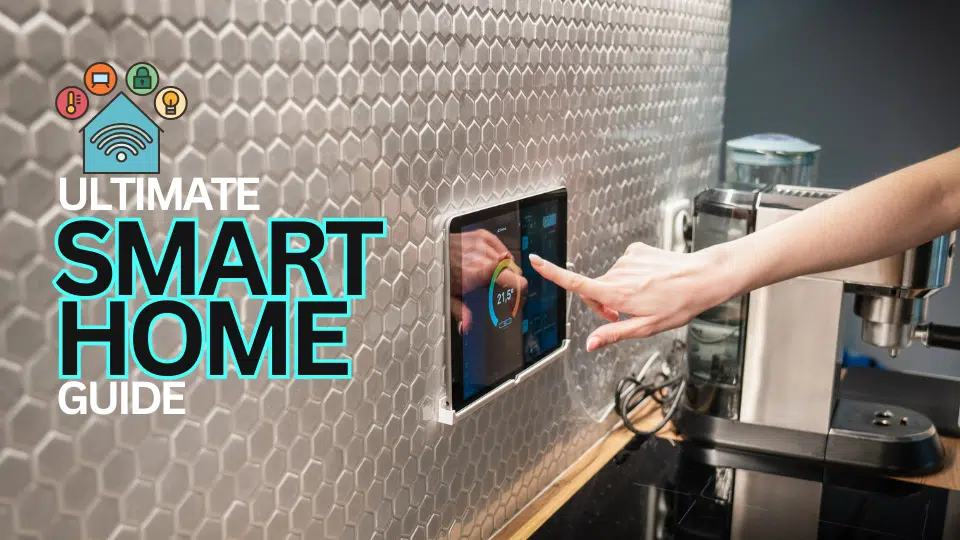Smart homes have revolutionized the way we live, offering convenience, security, and energy efficiency like never before.

- Benefits of having a smart home
- Factors to consider before creating a smart home
- Smart home devices: An overview
- Popular smart home systems
- Enhancing security with smart home technology
- Smart home technology for energy efficiency
- Smart home automation: Simplifying daily tasks
- How to choose the right smart home devices for your needs
- Setting up your smart home: A step-by-step guide
- Maintaining and troubleshooting your smart home
- Future trends in smart home technology
- Conclusion
By integrating advanced technology into our living spaces, we can control various aspects of our homes with just a touch of a button or a simple voice command. In this ultimate guide, we will explore the world of smart homes, discussing the benefits, factors to consider before creating one, popular devices and systems, as well as tips for setting up and maintaining your smart home.
Benefits of having a smart home
One of the primary advantages of having a smart home is the convenience it brings to your everyday life. With smart home devices, you can control your lights, thermostat, and even appliances remotely. Imagine being able to turn off the lights or adjust the temperature of your home while you’re on vacation or stuck in traffic.
Additionally, smart home systems can learn your preferences and automate tasks, making your life easier and more efficient.
Another significant benefit of a smart home is enhanced security. Smart security systems offer features such as video surveillance, doorbell cameras, and motion sensors, allowing you to monitor your home from anywhere. You can receive real-time alerts on your smartphone when someone approaches your front door or when there is unexpected activity detected inside your home. This level of security brings peace of mind and ensures the safety of your family and property.
Factors to consider before creating a smart home

Compatibility
Before diving into the world of smart homes, there are a few factors to consider. Firstly, compatibility is crucial. Ensure that the smart home devices you choose are compatible with each other and can be controlled from a single interface. Research and choose a smart home system that supports the devices you want to integrate seamlessly.
Budget
Budget is another important consideration. While smart home technology has become more affordable in recent years, the cost can still add up, especially if you plan to automate your entire home. Prioritize the devices that align with your needs and budget, and gradually expand your smart home ecosystem over time.
Privacy and Security
It’s also essential to think about the privacy and security implications of connecting your home to the internet. Ensure that the devices you choose have robust security features and regularly update their firmware to protect against potential vulnerabilities.
Smart home devices: An overview
Smart home devices come in various forms and serve different purposes. Let’s explore some of the most popular ones:
- Smart speakers and voice assistants: These devices, such as Amazon Echo or Google Nest Audio, allow you to control other smart devices using voice commands. They can also play music, answer questions, and provide weather updates.
- Smart thermostats: These devices learn your temperature preferences and adjust the heating or cooling accordingly. They can also be controlled remotely, helping you save energy and reduce utility bills.
- Smart lighting: With smart bulbs and switches, you can control the lighting in your home using your smartphone or voice commands. You can schedule lights to turn on and off at specific times or create different lighting scenes for different moods.
- Smart locks: These devices allow you to lock and unlock your doors remotely. Some smart locks also provide temporary access codes for guests or service providers, eliminating the need for physical keys.
Popular smart home systems
When it comes to smart home systems, there are several popular options available. Here are a few worth considering:
- Apple HomeKit: Designed for Apple users, HomeKit allows you to control smart devices using your iPhone, iPad, or Apple Watch. It offers a secure and seamless integration of various devices, ensuring a smooth smart home experience.
- Google Nest: Google Nest provides a range of smart home products, including thermostats, cameras, and speakers. The devices work together seamlessly and can be controlled using the Google Home app or voice commands.
- Amazon Alexa: Alexa is Amazon’s voice assistant, and it works with a wide range of smart home devices. With an Echo device, you can control your smart home using voice commands and even create routines to automate multiple tasks simultaneously.
Enhancing security with smart home technology
One of the most significant advantages of a smart home is the ability to enhance security. Smart home security systems offer a wide range of features that can help protect your home and loved ones. Here are some key aspects to consider:

Video Surveillance
Smart cameras allow you to monitor your home remotely and receive real-time alerts when motion is detected. Some cameras even offer facial recognition technology, enabling you to identify familiar faces and filter out false alarms.
Doorbell cameras
These devices provide a live video feed of your front door, allowing you to see and communicate with visitors even when you’re not at home. They also often have built-in motion sensors and can send alerts to your smartphone.
Smart locks
Smart locks offer convenience and security by allowing you to lock and unlock your doors remotely. Some models can even be integrated with other smart devices, such as doorbell cameras, to provide a seamless home security experience.
By combining these smart home security devices, you can create a comprehensive system that provides peace of mind and protects your home from potential threats.
Smart home technology for energy efficiency
In addition to convenience and security, smart home technology also offers significant benefits in terms of energy efficiency. By monitoring and controlling various aspects of your home’s energy consumption, you can reduce your environmental impact and lower your utility bills. Here’s how:
- Smart thermostats: These devices learn your temperature preferences and adjust the heating or cooling accordingly. You can also control them remotely, allowing you to optimize energy usage based on your schedule.
- Energy monitoring: Smart plugs and energy monitoring devices can provide real-time data on your energy consumption. By identifying energy-hungry appliances, you can make informed decisions on how to reduce your energy usage.
- Lighting automation: Smart lighting systems allow you to schedule lights to turn on and off at specific times or adjust the brightness based on natural light levels. This not only saves energy but also creates a more comfortable living environment.
By leveraging these energy-saving features, smart homes contribute to a greener future while helping you save money on your energy bills.
Smart home automation: Simplifying daily tasks
One of the most exciting aspects of smart homes is the ability to automate daily tasks, making your life more convenient and efficient. Here are a few examples of how smart home automation can simplify your routines:
- Morning routines: By setting up automation routines, you can have your lights gradually turn on, your coffee maker start brewing, and your favorite news briefing play, all triggered by a single command or at a specific time.
- Home entertainment: With the integration of smart speakers, TVs, and streaming devices, you can control your entire home entertainment system with voice commands. You can ask your voice assistant to play your favorite shows or movies, adjust the volume, and even dim the lights for an immersive movie experience.
- Bedtime routines: Automate your bedtime routine by having your smart home system turn off the lights, lock the doors, and adjust the thermostat to your desired sleeping temperature, all with a simple command or a preset schedule.
By automating these tasks, you can save time and enjoy a more seamless and enjoyable daily routine.
How to choose the right smart home devices for your needs
With the wide variety of smart home devices available on the market, choosing the right ones for your needs can be overwhelming. Here are some key factors to consider when selecting smart home devices:
- Compatibility: Ensure that the devices you choose are compatible with your existing smart home system or the one you plan to invest in. This will allow for seamless integration and centralized control.
- Features: Assess the features offered by different devices and prioritize the ones that align with your needs. For example, if security is a top priority, focus on devices with advanced security features such as facial recognition or two-factor authentication.
- User-friendliness: Consider the ease of setup and use of the devices. Look for devices that have intuitive interfaces and provide clear instructions for installation and configuration.
- Reviews and recommendations: Read reviews and seek recommendations from trusted sources to get insights into the performance and reliability of the devices you’re considering. This can help you make informed decisions and avoid potential pitfalls.
By considering these factors, you can choose the right smart home devices that will enhance your lifestyle and meet your specific requirements.
Setting up your smart home: A step-by-step guide
Now that you have chosen the right smart home devices, it’s time to set up your smart home ecosystem. Here is a step-by-step guide to help you get started:
1. Plan your smart home
Identify the areas of your home where you want to incorporate smart devices. Consider the rooms where automation and control would bring the most convenience and efficiency.
2. Set up your smart home system
Follow the manufacturer’s instructions to set up your chosen smart home system. This typically involves connecting a hub or gateway device to your home network and installing the necessary companion app.
3. Connect your smart devices
Pair each smart device with your smart home system according to the manufacturer’s instructions. This usually involves scanning a QR code or following a guided setup process within the companion app.
4. Configure device settings
Once connected, use the companion app to configure the settings of each device. This may include setting up schedules, creating automation routines, and customizing device behavior.
5. Test and troubleshoot
Test each device to ensure it is functioning correctly and responding to commands. If you encounter any issues, consult the device’s user manual or contact customer support for troubleshooting assistance.
6. Expand your smart home
As you become more familiar with your smart home system, consider expanding your ecosystem by adding more devices and integrating additional features. This allows you to gradually enhance your smart home experience over time.
By following these steps, you’ll be well on your way to enjoying the convenience and benefits of a fully functional smart home.
Maintaining and troubleshooting your smart home
Like any other technology, smart home devices require regular maintenance and occasional troubleshooting. Here are some tips to keep your smart home running smoothly:
- Keep devices updated: Regularly check for firmware updates for your smart home devices and apply them promptly. These updates often include security patches, bug fixes, and performance improvements.
- Secure your network: Protect your smart home devices by securing your home network. Use strong, unique passwords for your Wi-Fi network and all smart device accounts. Consider enabling two-factor authentication for added security.
- Monitor device performance: Keep an eye on the performance of your smart home devices. If you notice any issues, such as slow response times or connectivity problems, troubleshoot them promptly. Restarting devices or resetting them to factory settings can often resolve common issues.
- Backup your settings: Some smart home systems allow you to back up your device settings and automation routines. Take advantage of this feature to avoid losing your configurations in case of device failure or system resets.
- Stay informed: Stay updated on the latest trends and developments in smart home technology. This will help you make informed decisions when expanding your smart home ecosystem and enable you to take advantage of new features and capabilities.
By following these maintenance tips and troubleshooting common issues, you can ensure the longevity and optimal performance of your smart home.
Future trends in smart home technology
The world of smart home technology is constantly evolving, and exciting advancements are on the horizon. Here are some future trends to look out for:
- Artificial Intelligence (AI) integration: AI-powered voice assistants will become more intelligent and capable, allowing for more natural and context-aware interactions with your smart home devices.
- Increased interoperability: As smart home technology matures, interoperability between different brands and devices will improve. This will enable easier integration and provide more options for customization.
- Energy harvesting: Smart home devices may harness energy from the environment, such as solar or kinetic energy, reducing reliance on batteries or constant charging.
- Enhanced security features: Smart home security systems will continue to evolve, offering advanced features such as facial recognition, advanced encryption, and real-time threat detection.
- Integration with smart cities: Smart homes will become more connected with smart city infrastructures, allowing for seamless integration and enhanced services such as automated waste management or optimized energy consumption.
As these trends become a reality, smart homes will become even more integrated into our lives, offering greater convenience, efficiency, and sustainability.
Conclusion
Creating a smart home opens up a world of possibilities, from convenience and security to energy efficiency and automation. By considering the benefits, factors to consider, popular devices and systems, and tips for setup and maintenance, you can embark on your smart home journey with confidence.
As technology continues to advance, the future of smart homes looks brighter than ever, promising even more innovation and integration. So, take the leap, and transform your home into a smart oasis that enhances your lifestyle and simplifies your daily routines.




